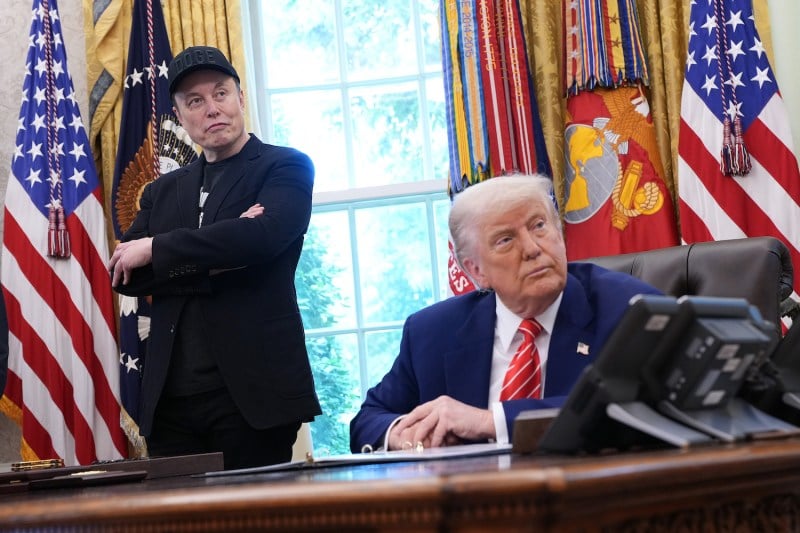Beijing’s Play for Sandy Cay

Beijing’s Play for Sandy Cay
China’s salami-slicing in the South China Sea is eroding U.S. credibility.
A Chinese coast guard boat sails near a container ship chartered by the Philippine military in the South China Sea on May 4. Jam Sta Rosa/AFP via Getty Images
Chinese activity in the South China Sea is intensifying once again—but it is drawing little international attention. Last month, the Chinese coast guard used water cannons against Philippine fishing boats, triggering a collision near Sandy Cay, which is fast becoming a new focal point of Chinese pressure and Philippine pushback in the South China Sea. This followed China’s decision to unfurl its national flag on the reef at the end of April—its first on-the-ground, formal assertion of sovereignty over a previously unoccupied land feature in more than a decade. The move came amid joint U.S.-Philippine military drills and as foreign governments were wrestling with tariffs imposed by U.S. President Donald Trump’s administration.
The last time China made a comparable move was in 2012 when, in response to Philippine naval authorities apprehending Chinese fishermen near Scarborough Shoal, Beijing increased coast guard and maritime militia presence, eventually establishing effective control. Scarborough Shoal remains unoccupied, but China retains control, granting or denying Philippine fishermen access at will, despite a 2016 international tribunal ruling affirming that Philippine, Chinese, Vietnamese, and Taiwanese fishermen enjoy traditional fishing rights there and that China had interfered with them.
Chinese activity in the South China Sea is intensifying once again—but it is drawing little international attention. Last month, the Chinese coast guard used water cannons against Philippine fishing boats, triggering a collision near Sandy Cay, which is fast becoming a new focal point of Chinese pressure and Philippine pushback in the South China Sea. This followed China’s decision to unfurl its national flag on the reef at the end of April—its first on-the-ground, formal assertion of sovereignty over a previously unoccupied land feature in more than a decade. The move came amid joint U.S.-Philippine military drills and as foreign governments were wrestling with tariffs imposed by U.S. President Donald Trump’s administration.
The last time China made a comparable move was in 2012 when, in response to Philippine naval authorities apprehending Chinese fishermen near Scarborough Shoal, Beijing increased coast guard and maritime militia presence, eventually establishing effective control. Scarborough Shoal remains unoccupied, but China retains control, granting or denying Philippine fishermen access at will, despite a 2016 international tribunal ruling affirming that Philippine, Chinese, Vietnamese, and Taiwanese fishermen enjoy traditional fishing rights there and that China had interfered with them.
Declaring sovereignty over Sandy Cay is not unlawful—China, Taiwan, the Philippines, and Vietnam all claim it. Located beyond any country’s 200-nautical-mile exclusive economic zone, Sandy Cay is mostly above water at high tide and legally capable of sustaining an independent sovereignty claim. All four claimants, in theory, may assert a valid claim.
What is worrying, however, is the on-the-ground assertion of sovereignty over a previously unoccupied feature, which also increases the risk of escalation, as we already see happening. In 2002, China and members of the Association of Southeast Asian Nations (ASEAN) signed the Declaration on the Conduct of Parties in the South China Sea, committing to “exercise self-restraint in the conduct of activities that would complicate or escalate disputes and affect peace and stability including, among others, refraining from action of inhabiting on the presently uninhabited islands, reefs, shoals, cays, and other features and to handle their differences in a constructive manner.” Although countries, particularly China, continued to reclaim and militarize features they already occupied, they stopped short of occupying new ones. China has not inhabited Sandy Cay, but it is pushing the limits of the 2002 declaration.
The territorial seas generated by Sandy Cay and nearby Thitu Island, occupied and administered by the Philippines since 1971, overlap almost completely, given that the two land features lie just two nautical miles apart. By asserting a claim over Sandy Cay, China inserts a competing claim onto the waters surrounding a major Philippine outpost, narrowing the Philippines’ operational space and complicating patrols and resupply. It also lays the legal groundwork for future challenges.
Like many of China’s gray-zone activities in the South China Sea, its unfurling of a flag on Sandy Cay is savvy and calculated. It is aimed at advancing claims while staying below the threshold of armed conflict. Although significant, this action was less overtly military than others it has undertaken in the South China Sea, including its use of water cannons against Philippine vessels in late May. Chinese coast guard and maritime militia have swarmed waters near Sandy Cay and restricted Philippine access to nearby Thitu Island. Elsewhere, most notably around Second Thomas Shoal, China has used lasers, fired water cannons, and rammed vessels. China uses small features like Sandy Cay, which is no larger than a few football fields, and micro actions to expand its presence and control, reinforce claims, and test the limits of what others, particularly the United States, will tolerate.
One of China’s key aims is to undermine U.S. credibility. Sandy Cay is not recognized Philippine territory and therefore not covered by the U.S.-Philippines Mutual Defense Treaty, but that legal nuance will be irrelevant to how the region perceives Washington’s response—or lack thereof. The Trump administration has already unsettled allies and partners through its treatment of Europe, its wavering on security commitments, and its indiscriminate tariffs. Allies and partners are sensitive to how Washington responds to every challenge, including this one, even if many in the region do not share the Philippines’ zeal in pushing back against illegal Chinese claims. Beijing timed its assertion of sovereignty against Sandy Cay well.
Beijing’s assertiveness in the South China Sea is counterproductive, and it would benefit from greater restraint—the U.S. position in Southeast Asia is weakening, particularly after Trump’s tariffs and China’s high-profile regional diplomacy that followed soon after. During Chinese President Xi Jinping’s visit to Southeast Asia in mid-April, 113 agreements were signed. While few may materialize, they helped portray China as constructive and the United States as absent or even punitive. China could have quietly accrued goodwill. Directly asserting sovereignty over a previously unoccupied feature and other expansive actions remind the region why China cannot be trusted, even amid growing frustration with Washington.
But China likely engages in acts like these because it can. In 2024, for the first time in an annual survey conducted by the Singapore-based ISEAS-Yusof Ishak Institute, a majority of Southeast Asian government and nongovernment elites said they would align with China over the United States if forced to choose, despite low trust in China to “do the right thing” and concerns over the South China Sea.
In the 2025 survey, the United States regained ground. Trump’s return—the poll, although released in early April, was conducted before his “Liberation Day” tariffs—and growing unease over China’s increasingly assertive actions in the South China Sea were key factors. But China can dial up or down its activities there, and its actions are often overlooked given its economic clout and sustained diplomatic engagement. Even in 2025, respondents from three of the five Southeast Asian countries with territorial or maritime disputes with China—Brunei, Malaysia, and Indonesia—still overwhelmingly leaned toward Beijing. Of the remaining two—the Philippines and Vietnam—Vietnam will almost certainly, if forced to choose, also lean toward China if only government officials are surveyed. Despite economic headwinds, China remains the region’s largest trading partner and a key investor, with close party-to-party ties to Vietnam. Last week, China joined ASEAN and the Gulf Cooperation Council (GCC) countries in an inaugural ASEAN-GCC-China summit aimed at fostering greater tripartite economic and strategic cooperation. To date, ASEAN has not issued a strong statement calling out China for its actions in the South China Sea.
While the Trump administration favors spectacle and direct confrontation, China’s approach is quieter and more incremental. For the most part, its salami-slicing in the South China Sea has attracted little response from the Trump administration. The U.S. ambassador to the Philippines posted on X that the Chinese coast guard’s “aggressive actions against a lawful civilian mission near Sandy Cay recklessly endangered lives and threaten regional stability” and that the United States “stand[s] with our Philippine allies in support of international law and a free and open Indo-Pacific.” In April, a spokesperson for the U.S. National Security Council stated, “The reports of China seizing Sandy Cay reef are deeply concerning if true.” China is steadily consolidating its position, operating in legal and operational gray zones, while the Trump administration has thus far failed to enunciate clear goals in the Indo-Pacific and how it plans to achieve them with allies and partners, even as its planned tariffs hurt friend and foe alike and the administration casts doubt on long-standing security commitments.
China does not need decisive wins; it only needs to keep accumulating advantages. Sandy Cay is one more move in a long game that is gradually reshaping the region’s strategic order. Washington should not ignore these micro-contests. It can and should signal that occupying Sandy Cay and other unoccupied features is destabilizing and will have consequences for U.S.-China relations—former President Barack Obama’s administration issued a similar warning in relation to Scarborough Shoal, which China has refrained from occupying. The difficulty now, of course, is that U.S.-China ties are so frayed that Washington may struggle to impose meaningful costs—its blitzkrieg strategy toward China is impacting its ability to shape Beijing’s behavior.
U.S. credibility in the region can erode over major decisions, such as the indiscriminate imposition of tariffs, and seemingly minor ones, like inaction over Sandy Cay. Credibility is weakened not only at the core, but at the margins—and this ultimately results in lost influence and power.
Lynn Kuok is the Lee Kuan Yew Chair in Southeast Asia Studies at the Brookings Institution. She is also a senior research fellow at the University of Cambridge.
Stories Readers Liked
In Case You Missed It
A selection of paywall-free articles

Four Explanatory Models for Trump’s Chaos
It’s clear that the second Trump administration is aiming for change—not inertia—in U.S. foreign policy.





















Join the Conversation
Commenting is a benefit of a Foreign Policy subscription.
Subscribe
Subscribe
Already a subscriber?
.
View Comments
Join the Conversation
Join the conversation on this and other recent Foreign Policy articles when you subscribe now.
Subscribe
Subscribe
Not your account?
View Comments
Join the Conversation
Please follow our comment guidelines, stay on topic, and be civil, courteous, and respectful of others’ beliefs.
View Comments
Change your username |
Log out
Change your username:
CANCEL
Confirm your username to get started.
The default username below has been generated using the first name and last initial on your FP subscriber account. Usernames may be updated at any time and must not contain inappropriate or offensive language.